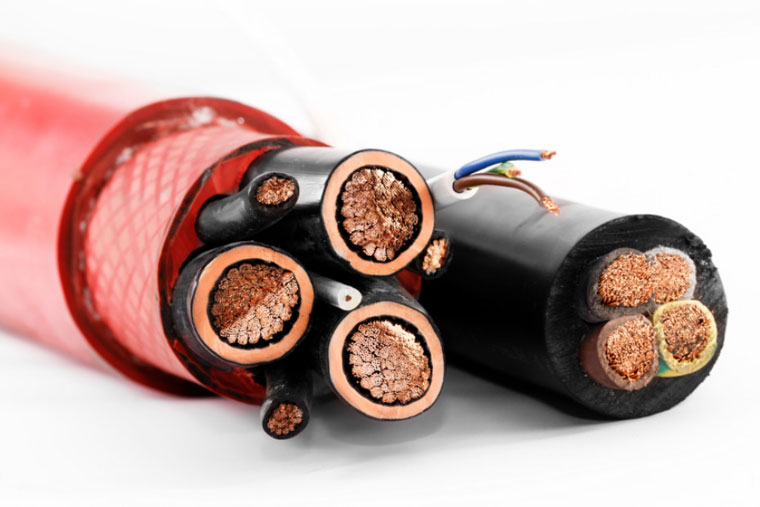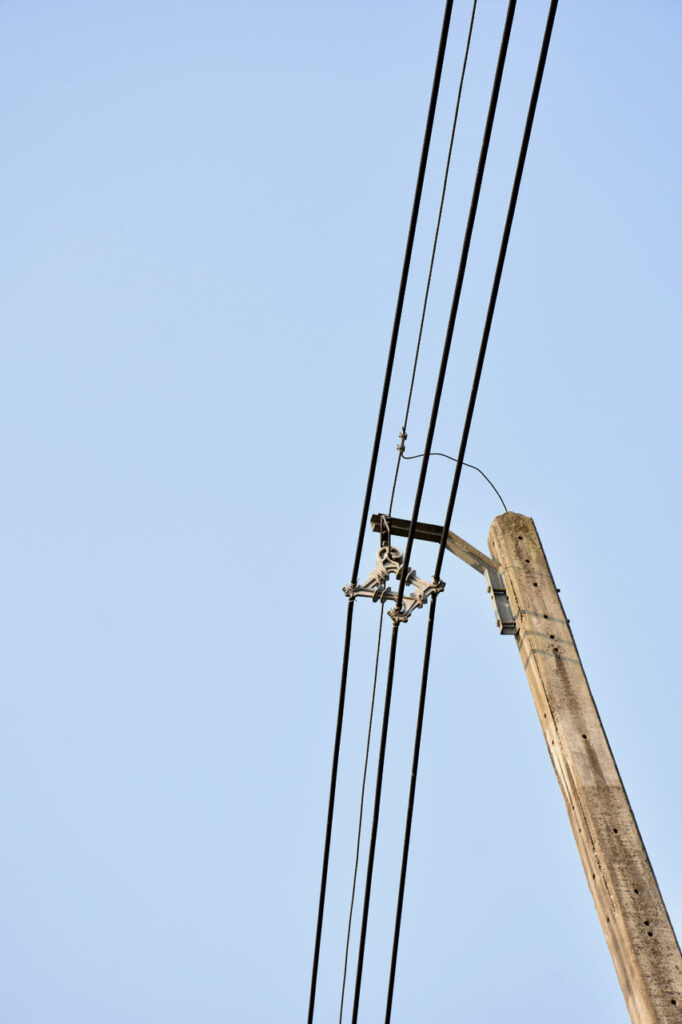Solutions to Electrical Faults and Wildfire Ignitions
Here you can learn about Insulated Modern Power Cables and Advanced Circuit Protection
Cable Strength and Insulation
The first and most important factors in overhead circuit safety are the insulation and tensile strength of conductor cables and jumpers. Most fires are started by phase to phase, and phase to ground faults. (Jumpers are the short sections of electricity conductors that convey power between different equipment on power poles). Insulation of conductors would resolve most fire ignition risks. Imagine your house with uninsulated wire. It’s impossible.
Heat buildup with insulated conductors must be considered. Small diameter utility wires heat up from resistance when too much current is passing through them. But because they are uncovered, bare wires can shed heat easily. Therefore to avoid heat buildup, insulated cables need to be larger in diameter so they do not heat up and damage their insulation. An increase in conductor size can resolve both the heat and the tensile strength issue. The strongest common overhead cables are ACSR or “aluminum conductor steel reinforced”. Cover ASCR with XLPE (cross linked polyethylene) and other insulation layers, and you have a fire-safe distribution voltage cable that will work anywhere to dramatically improve wildfire safety.
The only reason that overhead utility conductors remain uninsulated is cost. Materials science has developed insulating materials that can withstand decades of sunlight exposure and abrasion without degrading. Originally, wire insulation could not sustain years of sunlight. Now XLPE and other materials last over 40 years in full weather exposure.
Most of the distribution voltage wire PG&E uses is old, and only a small percentage is fully insulated.
We can have safe insulated power cables over our roads, streets and backyards. All high wildfire threat districts need strong insulated cables if utility ignited wildfires are going to be prevented.
Southern California Edison (SCE) has now focused on replacing their uninsulated overhead conductors in High Wildfire Threat Districts with triple insulated cables, because this is the most cost effective way to stop wildfire ignitions. PG&E continues destroying trees as its way to achieve fire safety. This eludes our comprehension.
The new CEO of PG&E announced at a press conference during the Dixie Fire that the company was going to underground 10,000 miles of distribution cables. Don’t hold your breath. PG&E has had five CEOs since 2017. Undergrounding is very safe and far more attractive looking, but it is quite expensive. We support undergrounding in principle. But thousands of miles of circuits need to be upgraded quickly now that California is facing rapidly worsening wildfires caused by global warming.
Cable Innovations
A dramatic new innovation in utility cable design are new carbon transmission cables. These conductors are made from a carbon composite encased in aluminum. This type of cable is much lighter than the ACSR designs patented in the early 20th century. Also this new design cable has a lower electrical resistance. The owner/operators of transmission circuits have replaced the ACSR on existing transmission tower circuits and dramatically increased the capacity of these circuits. This new cable allows a major load carrying increase on existing circuit easements. Increased capacity is needed for the energy transition away from fossil fuels. Southern CA Edison has already installed this type of cable in California.
You’ve read this far and now know how important insulated conductors are. Below are a few examples of this type of equipment.
In European cities, power utilities run power cables from building to building attached directly to the building and sometimes running under the edges of balconies where a child could reach it. This cable is a jacketed conductor, a single multi-conductor cable. You can safely touch this cable and not feel anything from the high voltage.
Insulated Power Cables
Below are two examples of modern, very strong and safe utility cables. These multi-phase cables are so well insulated that they can conduct huge wattages with no electricity leakage. These photos are of European origin, but this type of cable is an internationally available product and is made in many versions for different installations. The red, multi-conductor cable is intended for undergrounding. The black cable could likely be used outside on buildings. There is no need for multiple cables.

The black cable below contains a single twisted bundle of aluminum stranded conductor. It is surrounded by a copper “neutral” conductor to control magnetic field impacts and prevent inductive interference with adjoining cables. This is a true high voltage transmission cable that can run underground.

Below is the Gold Standard for Overhead Power Circuit Safety. This is called “Spacer Cable.”
In this system, a steel “messenger wire” supports a bracket that holds the 3-phase insulated conductor cables. The support brackets are spaced out along each pole to pole span.
This system is “bomb proof”. Many true publicly owned utilities in other states like Massachusetts use this system because it prevents nearly all power outages. It is so strong that large tree branches simply bounce off and fallen trees do not necessarily knock it down. Because it is fully insulated and can be used with insulated connection clamps, it is highly fire-safe and low maintenance.
This cable can be driven to the ground without breaking the cable, causing a power outage, or least of all, starting a wildfire.

Cross-Bar-Suspended Cable can also be very Fire-Safe
Southern California Edison (SCE) is replacing far more circuit miles of old wire than is PG&E. SCE is using a triple covered (insulated) ACSR. ACSR is a common design of steel core stranded aluminum cable. When this type of cable is fully insulated, it is very strong and highly resistant to object impacts, phase to phase arcs, and object contact arc faults of all kinds. An author of this website handled this cable during a presentation that SCE made to the CA Public Utilities Commission (CPUC). It is far superior in regard to safety than certain types of cable that PG&E continues to use.
You can see a copy of SCE’s presentation to the CPUC about their success with this type of highly safe utility cable. Just type into your internet browser search window: “SCE February 27, 2019 CPUC Covered Conductor Workshop“. This is not a hyperlink. It is simply search text.
Circuit Protection
Circuit protection is a term for equipment that can detect electrical faults and shut down (open) an electrical circuit before it causes system damage, sustained power outages, electrocutions or wildfires. A circuit safety relay is another term for these devices. Utility circuits conduct immense power. Their destructive potential is equal to that power.
Fuses and Circuit Breakers
A fuse is the most basic circuit protection. The first fuses were used on telegraph lines by 1860. Fuses place a limit on the amperage flowing in a circuit and prevent overloads by heating up and melting or burning out if the amperage get too high. The conductive metal inside the fuse separates. This opens the circuit and stops the flow of electrical current. The fuse must also protect against an electrical arc forming between the remnants of the fused material in a capsule. This can be done by filling the fuse capsule with non-conductive powder or fluid. A fuse is a sacrificial protection device. Once it functions, it is destroyed and must be replaced.
There is a type of utility fuse still widely in use that opens the circuit by explosively expelling out its core. These are called expulsion fuses. These fuses are dangerous if the molten core lands in dry vegetation where it starts a fire. There are also fuses called “open link fuses” and “solid blade disconnects”. These can also start wildfires. But all three are still allowed by the CPUC.
Safe, contained, and non-fire starting fuses are widely available. They should be used by every electrical power utility. The CPUC has no specifications for utility fuses.
Circuit breakers (which in function can also include sectionalizers and reclosers) also protect against overloads as fuses do. But they are re-useable, and depending on their design (reclosers) can automatically re-energize the circuit after a transitory electrical fault (such as a bare conductor cable wind slap) has corrected or “cleared”. This is why you experience brief power outages during high winds. Utility circuit breakers are often magnetic field operated rather than thermal. A magnetic circuit breaker functions when a build-up of inductive magnetic force from a power overload trips open the circuit. A thermal circuit breaker opens on overloads by pressure when they heat up and create force that opens the contacts in the breaker. Both types of circuit breaker can only protect against power overloads (excess amperage and “short circuits”).
Over Voltage Protection
Lightning strikes on or near to powerlines, and also large loads switching on and off in a circuit will both produce voltage surges in that circuit. These surges of excess voltage can be dangerous for several reasons. For example, they can damage or destroy the electrical equipment in your home. Often large capacitor banks in substations are used to absorb and mitigate voltage surges. These capacitor banks balance and stabilize the voltage in utility circuits. Excess voltage can cause flash-overs of the ceramic insulators that isolate electricity from power poles and high voltage transmission towers. Flashovers are very dangerous.
Computerized Circuit Protection
Note: There is sophisticated electrical engineering involved here. This website is not a source for engineering advice. Our point is to explain general principles about equipment that can dramatically improve the fire ignition safety of utility circuits.

Advanced modern circuit protection includes the use of small robust computers to “watch” the current wave form in conductor cables and “read” the wave form distortions in the alternating current (AC).
There is a lot of “noise” in a utility supply circuit. This made these developments technically difficult. The introduction of distributed energy, including small roof top solar systems ads to this complexity. Every time you flip a switch in your house this induces more noise into the utility circuit. Designing computers capable of sorting through all these noise signals to recognize dangerous electrical faults is complex. The first successful high impedance arc fault interruption system in the United States, was developed at Texas A&M University and later installed by GE and Potomac Power on the East Coast.
If you think of an oscilloscope screen displaying a wave form, this is what this computer does. Contained in the computer’s memory are numerous examples of wave form distortions that indicate different types of electrical faults. The computer is continuously taking samples of the AC wave form and comparing these real time samples to those contained in its memory. When the computer detects a match, it instantly opens a switch and shuts off the current. These computer devices are coupled with existing or new switch gear to create very safe utility circuits.
This system was developed to protect against high impedance arc faults. This is the “downed wire” fault. These are very dangerous because they often do not trip off any conventional type of fuse or recloser. The fallen conductor remains energized and arcing (sparking) to earth.
When a utility conductor falls to earth while energized the resulting fault current has low power. This is because the earth is a poor conductor of electricity and the high impedance prevents the fault current from getting powerful enough to trip off (open) fuses or reclosers. Nevertheless this is the cause of many wildfires.
A single system available today can protect against overcurrent, overvoltage, load encroachments, arc flash, and phasing frequency errors; essentially every common utility power fault.
These devices can be mounted on power poles to protect sections of a distribution grid or they can be installed in substations to protect entire circuits.
General Electric now has available what they call “GridNode High-Speed Falling Conductor Protection.” GE makes it clear that their system, based in sub-stations, can de-energize both broken transmission and distribution cables before they fall to earth, or in 1.3 seconds. This protection speed and level of circuit safety could possibly make overhead power as safe as undergrounding.
General Electric, Schweitzer Engineering Labs and ABB (a Swiss, Swedish multi-national conglomerate) have all developed advanced micro-processor based, circuit protection equipment that can dramatically improve the safety of overhead utility circuits.
SCADA –– Supervisory Control and Data Acquisition
This older technology is critical to managing water systems, industrial plants and virtually all complex and geographically separated system management. SCADA signals can use wired phone lines, cell phone systems, internet, and secure radio frequency transmission.
For example a water district uses SCADA to monitor its storage tanks, operate its pumps and filtration equipment, and monitor water quality remotely in real time. SCADA is essential. For an electric power utility SCADA allows the safe operation of a grid by providing real time monitoring and remote operation of switch gear and other critical equipment.
A major reason any power utility company can take so long to turn the power back on after a power outage is that their linemen have to identify and locate the circuit fault that caused the power to shut off. Without SCADA or a related system, this identification of the fault is frequently done by driving around looking, often in the dark with spot lights, for the fault that caused the power to shut off. The more site-specific location information that’s available to a power utility, the safer their system will be.
Powerline faults need to be located fast. The fault could be a live wire on a sidewalk, or a transformer failing catastrophically, or a separated transmission line jumper lashing against the transmission tower and showering sparks.
The only SCADA equipment we have personally seen PG&E use appear to be indicators on their recloser devices. We assume they must have SCADA in their sub-stations. We have not personally seen a recloser that PG&E can open remotely.
A PG&E “troubleman” took hours to reach the likely site of the Dixie Fire ignition. A SCADA signal to open a remotely operated upstream recloser on that circuit could likely have prevented this huge disastrous wildfire. Fuses did not prevent that fire, nor could linemen and trucks.
